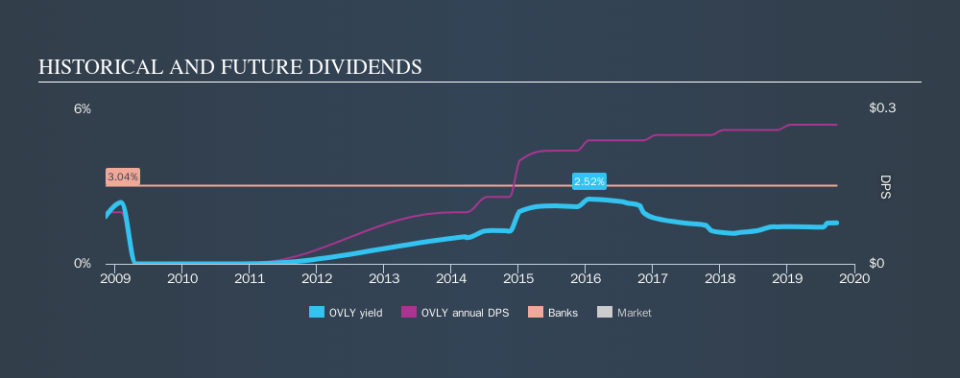What Makes Oak Valley Bancorp (NASDAQ:OVLY) A Great Dividend Stock?

Dividend paying stocks like Oak Valley Bancorp (NASDAQ:OVLY) tend to be popular with investors, and for good reason - some research suggests a significant amount of all stock market returns come from reinvested dividends. Unfortunately, it's common for investors to be enticed in by the seemingly attractive yield, and lose money when the company has to cut its dividend payments.
While Oak Valley Bancorp's 1.6% dividend yield is not the highest, we think its lengthy payment history is quite interesting. Some simple analysis can offer a lot of insights when buying a company for its dividend, and we'll go through this below.
Explore this interactive chart for our latest analysis on Oak Valley Bancorp!
Payout ratios
Dividends are typically paid from company earnings. If a company pays more in dividends than it earned, then the dividend might become unsustainable - hardly an ideal situation. So we need to form a view on if a company's dividend is sustainable, relative to its net profit after tax. Oak Valley Bancorp paid out 18% of its profit as dividends, over the trailing twelve month period. We like this low payout ratio, because it implies the dividend is well covered and leaves ample opportunity for reinvestment.
Consider getting our latest analysis on Oak Valley Bancorp's financial position here.
Dividend Volatility
From the perspective of an income investor who wants to earn dividends for many years, there is not much point buying a stock if its dividend is regularly cut or is not reliable. For the purpose of this article, we only scrutinise the last decade of Oak Valley Bancorp's dividend payments. The dividend has been cut by more than 20% on at least one occasion historically. During the past ten-year period, the first annual payment was US$0.10 in 2009, compared to US$0.27 last year. This works out to be a compound annual growth rate (CAGR) of approximately 10% a year over that time. Oak Valley Bancorp's dividend payments have fluctuated, so it hasn't grown 10% every year, but the CAGR is a useful rule of thumb for approximating the historical growth.
It's not great to see that the payment has been cut in the past. We're generally more wary of companies that have cut their dividend before, as they tend to perform worse in an economic downturn.
Dividend Growth Potential
Given that the dividend has been cut in the past, we need to check if earnings are growing and if that might lead to stronger dividends in the future. Strong earnings per share (EPS) growth might encourage our interest in the company despite fluctuating dividends, which is why it's great to see Oak Valley Bancorp has grown its earnings per share at 15% per annum over the past five years. Rapid earnings growth and a low payout ratio suggests this company has been effectively reinvesting in its business. Should that continue, this company could have a bright future.
Conclusion
To summarise, shareholders should always check that Oak Valley Bancorp's dividends are affordable, that its dividend payments are relatively stable, and that it has decent prospects for growing its earnings and dividend. Firstly, we like that Oak Valley Bancorp has a low and conservative payout ratio. Next, earnings growth has been good, but unfortunately the dividend has been cut at least once in the past. Overall we think Oak Valley Bancorp is an interesting dividend stock, although it could be better.
See if management have their own wealth at stake, by checking insider shareholdings in Oak Valley Bancorp stock.
Looking for more high-yielding dividend ideas? Try our curated list of dividend stocks with a yield above 3%.
We aim to bring you long-term focused research analysis driven by fundamental data. Note that our analysis may not factor in the latest price-sensitive company announcements or qualitative material.
If you spot an error that warrants correction, please contact the editor at editorial-team@simplywallst.com. This article by Simply Wall St is general in nature. It does not constitute a recommendation to buy or sell any stock, and does not take account of your objectives, or your financial situation. Simply Wall St has no position in the stocks mentioned. Thank you for reading.

 Yahoo Movies
Yahoo Movies 

